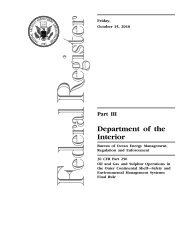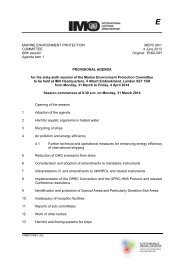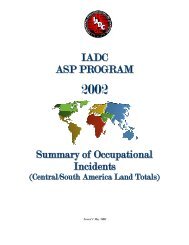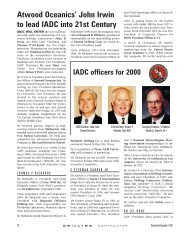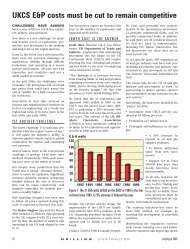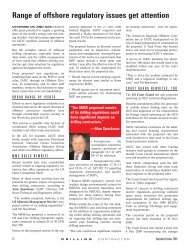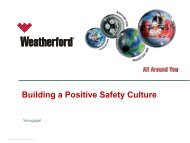iadc hse rig pass orientation program employee assessment checklist
iadc hse rig pass orientation program employee assessment checklist
iadc hse rig pass orientation program employee assessment checklist
You also want an ePaper? Increase the reach of your titles
YUMPU automatically turns print PDFs into web optimized ePapers that Google loves.
Employee Name____________________________________________<br />
_<br />
Supervisor_________________________________________<br />
Location___________________________________________<br />
IADC HSE RIG PASS ® ORIENTATION PROGRAM<br />
EMPLOYEE ASSESSMENT CHECKLIST<br />
FORM SCO-16<br />
INSTRUCTIONS:<br />
This form may be used to document an employer's participation in a basic <strong>orientation</strong> <strong>program</strong>. As each topic is completed, the <strong>employee</strong><br />
and instructor should both initial the appropriate box and note the date the item was completed. When all items are complete, the<br />
employer may issue a RIG PASS completion card. The employer should keep the o<strong>rig</strong>inal of this form on file.<br />
Topic<br />
Employee<br />
Initials<br />
Instructor<br />
Initials<br />
Date<br />
I. General Safety<br />
A. Principles<br />
1. Employee safe work practices are a condition of<br />
employment<br />
2. Workplace injuries are preventable<br />
3. Lead through example<br />
4. Safety is important both on and off the job<br />
5. Each individual's safety performance has a direct<br />
bearing on his/her employer's ability to work in the<br />
industry<br />
6. Workplace injuries are costly<br />
7. Attitude is contagious<br />
B. Alcohol and Drug Policies<br />
1. Defined/where posted<br />
a. Service contractor<br />
b. E & P operator (if different)<br />
2. Search and seizures<br />
SCO-16 Employee Assessment Checklist Page 1<br />
Revision 5 Last updated: 8 June 2012
Employee Name____________________________________________<br />
_<br />
Supervisor_________________________________________<br />
Location___________________________________________<br />
Topic<br />
Employee<br />
Initials<br />
Instructor<br />
Initials<br />
Date<br />
3. Testing<br />
4. Reporting of prescription medications<br />
5. Prohibit drug paraphernalia<br />
C. Firearms and Weapons Policy<br />
D. Personal Conduct<br />
1. No horseplay or practical jokes<br />
2. Observe smoking restrictions<br />
3. Practice respect for co-workers<br />
a. No ethnic, racial, religious or sexual<br />
harassment or jokes<br />
b. No profanity<br />
c. No excessive noise<br />
d. Proper dress on and off duty<br />
e. Attend to personal hygiene<br />
4. Prohibited items (i.e. stolen items, contraband, cell<br />
phones, highly caffeinated drinks)<br />
E. General Worksite Safety<br />
1. Intervention/Stop work<br />
2. Job Safety Analysis/Job Hazard Analysis<br />
(JSA/JHA)<br />
3. Pre-job planning meeting<br />
4. Site and unit specific <strong>orientation</strong><br />
5. Signs and placards<br />
SCO-16 Employee Assessment Checklist Page 2<br />
Revision 5 Last updated: 8 June 2012
Employee Name____________________________________________<br />
_<br />
Supervisor_________________________________________<br />
Location___________________________________________<br />
Topic<br />
Employee<br />
Initials<br />
Instructor<br />
Initials<br />
Date<br />
F. Tools<br />
1. Inspect before use<br />
2. Take unfit tools out of service<br />
3. Use appropriate tools for the task<br />
4. Alternative cutting tools<br />
G. Housekeeping<br />
1. Importance<br />
2. Proper storage<br />
3. Walkways and aisles<br />
4. Spills and trip hazards<br />
5. On the job<br />
6. Signs, cones, banners and barricades<br />
H. Communications, Chain of Command<br />
1. Service contractor supervisor<br />
2. Operator supervisor<br />
I. Reporting and Investigating Incidents<br />
1. General procedures<br />
a. Bodily injury and first aid<br />
b. Property damage<br />
c. Vehicle accidents<br />
d. Near miss event<br />
e. Uncontrolled and/or unauthorized release to the<br />
environment<br />
f. Potential hazardous conditions<br />
2. Purpose of incident investigation<br />
SCO-16 Employee Assessment Checklist Page 3<br />
Revision 5 Last updated: 8 June 2012
Employee Name____________________________________________<br />
_<br />
Supervisor_________________________________________<br />
Location___________________________________________<br />
Topic<br />
Employee<br />
Initials<br />
Instructor<br />
Initials<br />
Date<br />
J. Land Transportation (As Applicable)<br />
1. Vehicle condition<br />
2. Driving practices<br />
a. Motor vehicle law<br />
b. Defensive driving<br />
c. Vehicle safety restraints<br />
d. Parking<br />
II.<br />
Personal Protective Equipment (PPE)<br />
A. Determining What PPE Is Needed<br />
1. Employee <strong>orientation</strong><br />
2. Job planning <strong>orientation</strong><br />
3. Site specific <strong>orientation</strong><br />
4. Operator's and contractor's safety policies<br />
5. Personal preferences<br />
6. Eliminate of uncertainties - asking co-workers or<br />
supervisors<br />
B. Head Protection<br />
1. Types<br />
2. Inspection<br />
3. Care and use<br />
C. Face and Eye Protection<br />
1. Types<br />
a. Protection<br />
b. Limitations<br />
c. Use in combination<br />
SCO-16 Employee Assessment Checklist Page 4<br />
Revision 5 Last updated: 8 June 2012
Employee Name____________________________________________<br />
_<br />
Supervisor_________________________________________<br />
Location___________________________________________<br />
Topic<br />
Employee<br />
Initials<br />
Instructor<br />
Initials<br />
Date<br />
2. Inspection<br />
3. Care and use<br />
D. Hearing Protection<br />
1. Types<br />
a. Protection<br />
b. Limitations<br />
c. Use in combination<br />
2. Inspection<br />
3. Care and use<br />
E. Foot Protection<br />
1. Types<br />
2. Inspection<br />
3. Care and use<br />
F. Hand Protection<br />
1. Types<br />
2. Inspection<br />
3. Care and use<br />
G. Respiratory Protection<br />
1. Medical questionnaire/test<br />
2. Fit testing<br />
3. Types of respirators<br />
4. Types of canisters<br />
5. Inspections<br />
6. Care and use<br />
SCO-16 Employee Assessment Checklist Page 5<br />
Revision 5 Last updated: 8 June 2012
Employee Name____________________________________________<br />
_<br />
Supervisor_________________________________________<br />
Location___________________________________________<br />
Topic<br />
Employee<br />
Initials<br />
Instructor<br />
Initials<br />
Date<br />
H. Fall Protection<br />
1. Types<br />
2. Inspection<br />
3. Care and use<br />
I. Other PPE<br />
1. Specialty clothing<br />
2. Care and use<br />
III.<br />
Hazard Communication and Materials Handling<br />
A. Types of Hazards<br />
1. Hazard communications<br />
2. Written plan<br />
3. Chemical inventory hazardous materials<br />
4. Container labeling<br />
5. Material safety data sheet<br />
a. Definition<br />
b. Location<br />
6. Safety equipment and <strong>employee</strong> responsibilities<br />
B. Transportation of Hazardous Materials<br />
1. Must be accompanied by material safety data sheet or<br />
a copy of the emergency response guidebook or<br />
equivalent<br />
2. Container must be properly labeled<br />
3. Must be accompanied by a properly completed<br />
manifest<br />
C. Uncontrolled/Unauthorized Release of Hazardous Materials<br />
SCO-16 Employee Assessment Checklist Page 6<br />
Revision 5 Last updated: 8 June 2012
(US equivalent = HAZWOPER)<br />
_<br />
Employee Name____________________________________________<br />
Supervisor_________________________________________<br />
Location___________________________________________<br />
Topic<br />
Employee<br />
Initials<br />
Instructor<br />
Initials<br />
Date<br />
1. Report the incident to the person in charge<br />
2. Do not respond to the release unless properly trained<br />
IV.<br />
Occupational Health<br />
A. Employee's Responsibilities in Dealing With Industrial<br />
Hygiene Hazards<br />
1. Know the hazards<br />
a. Do not handle or dispose of health hazards<br />
unless specifically trained or certified<br />
b. Report any suspicion of a health hazard to<br />
the person in charge<br />
2. Potential hazards at the work site<br />
a. Hydrogen sulfide (H2S)<br />
b. Diesel mist (oil-based mud)<br />
b. Noise<br />
c. Others<br />
V. Specialized Work Procedures<br />
A. Hazardous Energy Control (Lock-out/Tag-out)<br />
1. Define<br />
2. Coordination with authorized persons<br />
a. Operator/contractor safety manual<br />
b. Job planning meeting<br />
c. Site and unit specific <strong>orientation</strong>s<br />
3. Lock-out, tag-out, verify<br />
B. Work Permits (Confined Space and Hot Work)<br />
1. Define<br />
2. Types<br />
SCO-16 Employee Assessment Checklist Page 7<br />
Revision 5 Last updated: 8 June 2012
a. Confined space<br />
_<br />
Employee Name____________________________________________<br />
Supervisor_________________________________________<br />
Location___________________________________________<br />
Topic<br />
Employee<br />
Initials<br />
Instructor<br />
Initials<br />
Date<br />
b. Hot work<br />
c. Other<br />
3. Employee responsibility<br />
VI.<br />
Fire Safety<br />
A. Prevention<br />
1. Fire triangle<br />
2. Storage of flammables and combustibles<br />
3. Ignition Sources<br />
B. Employee responsibilities<br />
1. Report all fires and fire hazards immediately<br />
2. Be familiar with onsite fire protection<br />
3. Don't obstruct or block fire escape routes<br />
4. Don't tamper with fire extinguishing/apparatus<br />
5. Use fire extinguisher only if trained and authorized to<br />
do so<br />
6. Observe all precautions and procedures<br />
7. Participate in site specific fire drills<br />
8. Be aware of location and position of exit routes<br />
9. Know your responsibilities, station bill (muster list)<br />
and/or emergency evacuation plan<br />
VII.<br />
Materials Handling<br />
A. Mechanical Equipment<br />
1. Rules to follow when working around cranes/cherry<br />
pickers/forklifts<br />
a. Do not stand/walk under a suspended load<br />
SCO-16 Employee Assessment Checklist Page 8<br />
Revision 5 Last updated: 8 June 2012
Employee Name____________________________________________<br />
Supervisor_________________________________________<br />
_<br />
Location___________________________________________<br />
blades, needles or other sharp<br />
objects<br />
Topic<br />
Employee<br />
Initials<br />
Instructor<br />
Initials<br />
Date<br />
iii.<br />
Contaminated first aid materials<br />
(biohazards) must be properly<br />
handled in accordance with the site<br />
specific plan<br />
b. Report all exposures immediately<br />
C. Staphylococcus<br />
D. Health and Adverse Weather (as applicable)<br />
1. Lighting<br />
2. Windstorms<br />
3. Hurricanes/Typhoons<br />
4. Tornados/Cyclones<br />
5. UV Exposure<br />
6. Snow and Ice<br />
7. Flooding<br />
8. Thermal stress (heat stress/exhaustion, hypothermia,<br />
frostbite)<br />
E. Health and Wildlife, Insects and Snakes<br />
1. Snakes<br />
2. Insects (wasps, bees, mosquitoes, etc.)<br />
3. Spiders, scorpions<br />
4. Wildlife<br />
5. Rabid animals<br />
IX.<br />
Rig/Platform Environment<br />
A. Platform or Location Arrival Procedures<br />
SCO-16 Employee Assessment Checklist Page 10<br />
Revision 5 Last updated: 8 June 2012
Employee Name____________________________________________<br />
Supervisor_________________________________________<br />
_<br />
Location___________________________________________<br />
1. Use caution when using walkways (maintain footing<br />
and balance)<br />
Topic<br />
Employee<br />
Initials<br />
Instructor<br />
Initials<br />
Date<br />
2. Keep one hand free go hold handrails<br />
3. Get help with baggage or make multiple trips<br />
4. Sign in at checkpoint with person in charge or<br />
dispatcher<br />
B. Home Away From Home<br />
1. Be prepared for unexpected extended stays<br />
2. Bring sufficient quantities of personal items<br />
C. Understand The Site-Orientation (Ask Questions If You Do Not<br />
Understand)<br />
X. Emergency Response<br />
A. Alarms and Action to be taken<br />
1. Types<br />
a. Fire<br />
b. Blowout<br />
c. Abandon <strong>rig</strong><br />
d. H2S gas (if applicable)<br />
e. Combustible gas (if applicable)<br />
f. Man overboard (if applicable)<br />
g. All Clear<br />
XI.<br />
Wellsite Environmental Protection<br />
1. Waste management<br />
2. Leaks, spills, and releases<br />
3. Employee responsibilities<br />
4. DO NOT respond unless properly trained<br />
SCO-16 Employee Assessment Checklist Page 11<br />
Revision 5 Last updated: 8 June 2012
Employee Name____________________________________________<br />
_<br />
Supervisor_________________________________________<br />
Location___________________________________________<br />
NOTE: THE FOLLOWING SECTIONS ARE REQUIRED TO OBTAIN OFFSHORE ENDORSEMENT<br />
Topic<br />
Employee<br />
Initials<br />
Instructor<br />
Initials<br />
Date<br />
XII.<br />
Transportation<br />
A<br />
Arrival at Shorebase<br />
1. Check in with dispatcher or person in charge<br />
2. Inquire as to site specific <strong>orientation</strong><br />
3. Identify carry-on baggage (weight, quantity,<br />
hazardous material)<br />
4. Stand-by in designated waiting area until instructed to<br />
proceed by dispatcher or person in charge<br />
B. Helicopter Transportation<br />
1. The Pilot is in command and has complete authority<br />
2. Helicopter boarding and unboarding<br />
a. Board only when instructed to do so by the<br />
pilot<br />
b. Avoid the main rotor and tail rotor<br />
c. Secure loose items and hats<br />
d. Keep all objects over 4 feet in the horizontal<br />
position<br />
e. Secure personal baggage in the baggage<br />
compartment. Never go aft of the baggage<br />
compartment<br />
3. No smoking in or around the helicopter<br />
4. Wear your seat belt and the PFD provided in the<br />
helicopter<br />
5. Alert the pilot to anything unusual inside or outside of<br />
the craft.<br />
6. Be attentive during the helicopter <strong>orientation</strong>.<br />
SCO-16 Employee Assessment Checklist Page 12<br />
Revision 5 Last updated: 8 June 2012
Employee Name____________________________________________<br />
_<br />
Supervisor_________________________________________<br />
Location___________________________________________<br />
Topic<br />
Employee<br />
Initials<br />
Instructor<br />
Initials<br />
Date<br />
C. Boat Transportation<br />
1. The captain is in command and has complete<br />
authority<br />
2. Wear your PPE when boarding or leaving the vessel<br />
3. Report to the vessel crew for seating assignment and<br />
baggage storage<br />
4. Study the vessel station bill and know your<br />
responsibilities in case of an emergency<br />
D. Swing Ropes<br />
1. Locations<br />
2. Types<br />
E. Personnel Baskets<br />
1. Description<br />
2. Procedures<br />
XIII.<br />
Water Safety<br />
A. Personal Flotation Devices<br />
B. Survival Craft<br />
C. Standby Rescue Vessel<br />
XIV.<br />
Marine Debris<br />
A. Identification<br />
B. Reporting<br />
SCO-16 Employee Assessment Checklist Page 13<br />
Revision 5 Last updated: 8 June 2012
Employee Name____________________________________________<br />
_<br />
Supervisor_________________________________________<br />
Location___________________________________________<br />
NOTE:<br />
THE PROGRAM SELF-STUDY FOR SECTION XV IS REQUIRED ONLY FOR THOSE PROGRAMS SEEKING<br />
TO QUALIFY FOR LAND ENDORSEMENT.<br />
Topic<br />
Employee<br />
Initials<br />
Instructor<br />
Initials<br />
Date<br />
XV.<br />
Excavation – Trenching and Shoring<br />
A. Regulatory requirements<br />
B. Role of site worker, competent person<br />
C. Work practices<br />
D. Hazards relating to excavation work<br />
E. Methods of protection from excavation hazards<br />
F. Use of personal protective equipment<br />
G. Procedures regarding hazardous atmospheres<br />
H. Emergency and non-entry procedures<br />
SCO-16 Employee Assessment Checklist Page 14<br />
Revision 5 Last updated: 8 June 2012




